
Share this infographic on your site
Copy the code and paste it in your site
Width: 833 pixels
Width: 600 pixels
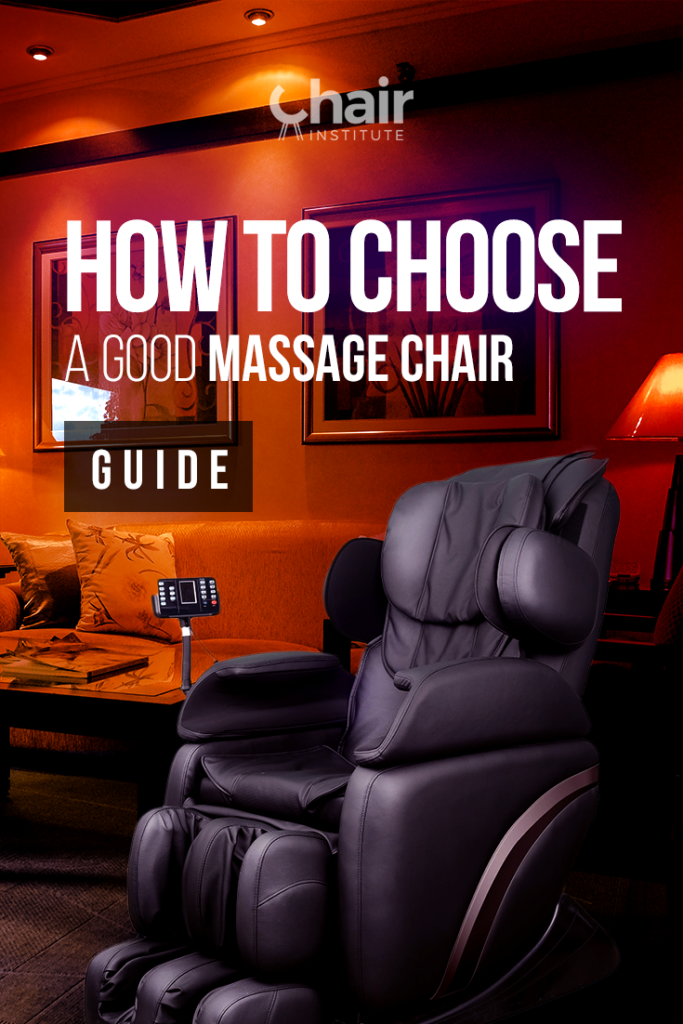
Are you in the market for a massage chair but overwhelmed by the sheer number of choices available?
Are you at your wit’s end trying to navigate through the labyrinth of features available to settle on the one that’s right for you?
In this piece, we’ll step you through the process of how to choose a good massage chair, so the one you ultimately buy will be a perfect fit, meeting all your needs at a price you can afford.
We’ll cut through the noise and distill the process down to its essentials, so you’ve got a clear, no-nonsense blueprint to follow that will make finding the right model a snap. Let’s get right to it!
How to Choose a Good Massage Chair
There are two key questions to ask before you even start. They are:
Your answers to these two questions provide the framework that will guide your thinking through the rest of the process. Once you have that information, what remains regarding figuring out how to choose a massage chair is much simpler, but answering them can be more complicated than you might think.
How much do you have to spend?
The budget side of the equation is easy. You know your expenses and how much you have to spend. In terms of broadly classifying massage chairs, use the following as a general guide:
Value Priced Chairs
These are inexpensive, but they trade features for the price reduction. In some cases, massage chairs in this category rely on outdated tech (though sometimes well-implemented) technology. In others, they simply use a scaled-back or narrowly focused feature set.
Mid-Range Chairs
This broad price range includes the vast majority of the massage chairs on the market today. You’ll find a variety of options here, from well-appointed generalist chairs to tightly focused chairs that utilize a more limited, but exceptionally well-implemented set of features designed to meet specific needs.
High-End Chairs
This vast category can extend as high as $14,000 or more, and of course, the more money you’re willing to spend, the more features and better implementations you can expect. Some of the chairs in this group are insane. They do just about everything and include plenty of convenience features that make them a joy to use and own.
Even though the chairs at the low end of the price spectrum are more limited, feature-wise, there are excellent models in every price bracket, so whatever your budget is, you can find something you’ll be pleased with.
Why do you want one?
The second question is a bit trickier, but here, the industry makes it a little easier for you. There are two basic types of massage chairs: Therapeutic and Hobbyist.
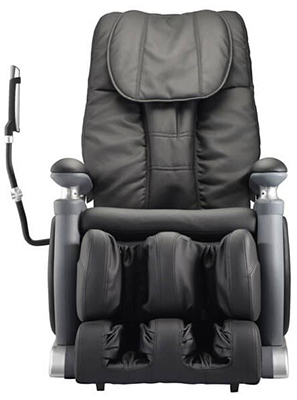
Therapeutic
Therapeutic chairs are designed to meet specific medical or chiropractic needs. The reality is that 8 out of 10 Americans will suffer from severe back pain at some point in their lives, and the numbers aren’t all that different in other parts of the world.
While relief from back pain is the most common reason people consider buying a therapeutic massage chair, it can be used to treat many other conditions, including neck and shoulder pain, leg pain, high blood pressure, and stress-related conditions.
Your “ideal” feature set will change based on your specific needs.

Hobbyist
Hobbyist chairs are more generalized in nature. They often include some therapeutic features, but tend to place as much or more emphasis on conveniences like MP3 support, memory slots that allow you to program and save your favorite massage settings, LED lights, and the like.
Of course, there’s considerable overlap, and just because your primary needs are therapeutic doesn’t mean you don’t appreciate certain convenience features either. But we’ll get to that in the next section.
So – how much do you have to spend, and what do you need it for? After all, if you suffer from chronic back pain, sciatica, or if you have a job that sees you spending several hours a day, all of those point to a very different set of features.
On the other hand, if all you want is a chair to kick back in and enjoy a soothing massage at the end of a long workday, that will lead you down yet another different path.
Features, Features, and More Features
So once you’ve got the answers to the two fundamental questions, the next step is to identify which massage chair features are most important to you.
Features fall broadly into three categories:
The best approach here is to list all the ones you’re interested in, then rank them in order of importance. Let’s take a look at each of them in turn.
Core Massage Chair Technologies
These are the essential elements that go into (or can go into) just about every massage chair. Consider these to be the bones around which the rest of any given design is built. They include:
Massage Track
Any conversation about a massage chair has to start here, and there are three different variations:
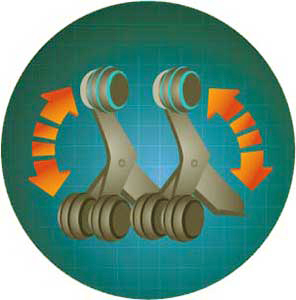
Roller Array
Rollers are the means by which the massage is rendered. The current industry standard is to utilize quad rollers, although some chairs use Tri- or Dual-rollers as a cost-saving measure. There are currently a few models that use a six-roller array, but this is relatively rare at this point.

The rule of thumb is more rollers = better massage experience.
Remember when we mentioned that some value-priced chairs utilize older technologies? This is one such case. Some chairs will use stationary massage heads or mated pairs of massage balls in the place of rollers.
These tend to render an inferior result, but massage balls are the best of the low-cost options, which don’t degrade the overall experience by any appreciable degree.
Roller Adjustment Technologies
There are four options here.

Massage Options
Roller-based massage can be rendered in a variety of ways. The more you’re willing to pay for your chair, the more techniques you’ll have available.
Techniques fall into two categories: Basic and Advanced.
Basic techniques are exactly what they sound like and include kneading, tapping, rolling, and the like.

Advanced massage techniques are typically named after the country that invented them: Swedish, Thai, Shiatsu in the case of a massage technique that hails from Japan, and so on.
Most massage chairs offer at least some ability to customize your roller-based massage via speed and intensity levels from the remote, but this is not always the case. In some low-priced models, you’ll only find a single setting, so it pays to dig a little to find out details like this if you’re looking to maximize your total number of customization options.
Air Massage Mode
Most massage chairs offer two different modes of massage: Roller-based and Airbag-based. Airbags are now in their second generation of development, so when looking for the right chair, it’s important to know whether the offered airbags are First Gen or Second Gen.
In general, the more airbags, the better your massage will be.
As with the roller-based massage, most chairs that offer airbags give you some ability to customize the experience via a level-based intensity adjustment on the remote, however, this is not a given, and a few low-priced models only offer a single air massage intensity level.
As you can see, there’s a lot more, even to the basic set of massage chair technologies, than first meets the eye!
Control Methodologies
There are three primary methods of operating a massage chair. Almost all of them feature a touchscreen LCD panel on a swing arm attached to the chair. About 90% of the models sold today also offer a remote for the sake of convenient operation while your massage is in progress. A very few offer app controls that allow you to access the chair’s features from your smartphone.
Therapeutic Features
These features are, simply put, included in massage chairs to help you feel better and solve for specific issues.
There’s no such thing as a “perfect” massage chair, and no chair on the market today has every feature on this list, and the list of features in the Hobbyist section, so it’s important to think about what you really want when it comes to this part.
Deep Tissue Massage
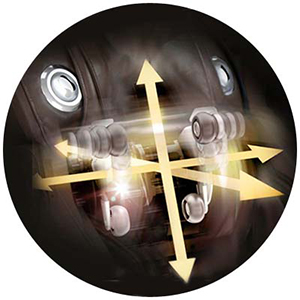
While a standard, roller-based massage feels great and even offers some therapeutic value, deep tissue massage is even better.
You’ll see this listed two ways in massage chair model descriptions. Sometimes, manufacturers will just come right out and say “deep tissue massage,” but other times, they’ll list this feature as “3D” or “4D” Technology.
The term “4D Technology” deserves some explanation. The reason it came into use was simply that if you have an S- or Hybrid L/S-Track chair, then the rollers already move in three dimensions because the track is bent to follow the curve of your spine, allowing for some degree of motion along the Z-Axis.
4D Roller Tech takes this to the next level by mounting the chair’s rollers on extension arms that enable them to move an extra 3” or so away from the massage track, allowing for a significantly more penetrating massage experience, which helps loosen those aching muscles.
Zero-Gravity Seating
This is a small but important feature that enhances the massage experience by placing you in a position such that your knees are elevated slightly above your heart, which gives you a feeling of weightlessness and allows your body’s weight to press more firmly against the chair back, which in turn, allows the rollers to render a deeper massage.
About a third of the massage chairs on the market today offer Zero-G seating and the models that do feature between 1-3 different seating positions.
Therapeutic Heat
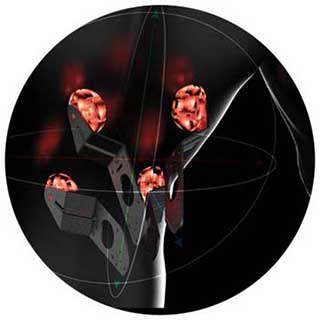
As good as massage is, heat + massage is even better. About half the chairs on the market today offer some type of heat. Of those, the overwhelming majority offer it in the lumbar region only.
A select few offer more extensive heat, sometimes in the leg massage ports (if the chair has them), others offer more extensive back heat, and one even has a heating blanket plus back heat to give you something approaching full-body heat.
The rule of thumb is, the more extensive the heat, the more expensive the chair. While it’s uncommon, you can sometimes find models that allow for precise temperature control, which is a nice perk, but its absence is seldom deal-breaking.
Body Stretch
This is hands down the most powerful therapeutic feature massage chairs can have. It provides immediate pain relief by taking pressure off the compressed discs in your spine.
Note that there are two other features that offer this same benefit in a less aggressive form: Waist Twist and Hip Swing. There are a few chairs that offer these features together with Body Stretching, which at first glance, seems redundant. When you think about it, though, that’s actually a very good thing from the user’s perspective.

Think about your chronic pain. From one day to the next, your pain level could vary wildly. On the days when the pain is especially bad, the Body Stretch might be too aggressive to use. In that case, it’s great to have a less aggressive option available, which is the very reason they’re sometimes paired in therapeutic models.
Point and Zone Massage Modes
Another fantastic therapeutic feature, this one allows you to interrupt any massage program currently running and focus the rollers exactly where you need them. You can spend as much time as you need to work the kinks out of your back before continuing with the massage program you’ve selected.
Calf and Foot Massage
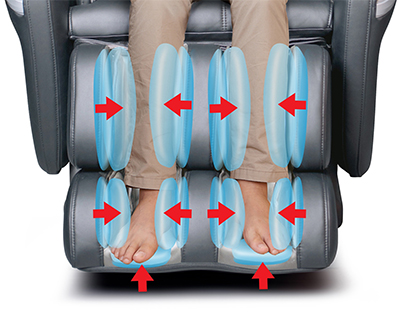
About two-thirds of the chairs on the market today feature leg massage ports. Most commonly, the calf massage is rendered by airbags, while the foot massage is rendered via dual rollers. Some cheaper chairs use a simple vibration-style massage for the soles of the feet.
More expensive chairs offer advanced features like tri- or quad-rollers for the soles of the feet, different types of massage (how would you like a Shiatsu foot massage? You can get that!), heated massage ports, and the like.
Convenience Features
While these features don’t directly improve the massage experience, they are attractive to different subsets of users. Here are the most common convenience features you’ll find:
Space-Saving Design
This is a big one and hugely important to people for whom space is at a premium. Most massage chairs require 18-24” of clearance between the chair back and whatever wall you set it near. Combine that with the fact that these chairs tend to be pretty big anyway, and they can completely fill up a room.

Chairs built with this feature only require about 4” of wall clearance, which makes it a fabulous addition to any design.
Extendable Ottoman
Most massage chairs are designed for people who range from between 5’ and 6’1” in height. About half the chairs on the market today feature an ottoman with an extension module, allowing them to accommodate users up to 6’5” in height.
Hideaway Ottoman
Aesthetics are very important to some people, and if there’s one thing that makes a massage chair stick out like a sore thumb in whatever room you have it in, it’s the presence of the leg massage ports.
The Hideaway Ottoman offers an ingenious solution to this problem. When you’re not using it to enjoy a massage, the leg ports can be folded into the chair itself, making it appear as just another piece of living room furniture.
You’ll pay a slight premium for this feature, but if aesthetics matter to you, then this addition is well worth it.
MP3 Support
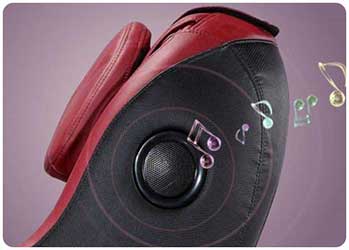
This is one of the most popular convenience features on the market today, because, after all, who doesn’t like listening to their favorite music while enjoying a relaxing massage?
There are three possible implementations for this feature in chairs that offer it:
Air Ionizer
The Air Ionizer feature is only offered in about 10% of chairs on the market today. It’s a small feature that some people find increases their relaxation by blowing a gentle draught of ionized air across the user’s face while the massage is in progress.
Chromotherapy
Some people find the soft glow of the LED lights mounted in chairs that offer chromotherapy to be highly relaxing, especially when combined with music. About 20% of the chairs on the market today offer chromotherapy feature.
Memory Slots

This feature is almost as popular as music support, but very few chairs offer it (only about 10% of the models on the market today). The reason why is a bit of a mystery. Memory is cheap and ubiquitous, so this should be an easy add, but there just aren’t many manufacturers that do it.
Most of the chairs that offer memory slots provide three, but a few provide 5-8, which is about the best you can get on the market today.
What makes this such a highly-prized feature is the fact that you can create the perfect massage experience using all your favorite features, then save it so you can recall it later at the touch of a single button. The more features, the more combinations you can save, or if other members of your family use it, they can use the extra slots to save their massage creations.
Making Your Selection
So, now that you have a sense of what features are available, the real fun begins.
Once you know what your budget is, and once you’ve got a good feel for why you want one, start thinking about what features are most important to you. If you wind up listing more therapeutic features. A good rule of thumb is:
Then, base your search on the collection of features you’ve prioritized. You may not find an exact match, but with the vast number of chairs on the market today, you’ll come quite close to finding your ideal!
How to Choose a Massage Chair Conclusion
As you can see, the question of how to choose a good massage chair is a lot more complex than first meets the eye.
Using this process, though, makes finding the perfect massage chair for you and your family a simple proposition. You’ll have a clear sense of what you want and how many features you can reasonably expect to find at each price point, bearing in mind, of course, that there will be some variance from one model to the next.
Happy hunting!




This was the most comprehensive explanation that I’ve found online. I wish I could find as comprehensive pros and cons of the different manufacturers. I’m torn between a Kahuna and an OOTori. The OOTori seems to be a better price/features, but not sure of reliability/quality. Thanks for the article!!! John
Hello John and thank you for the compliment! We’ve worked hard to ensure that we’re putting out accurate and complete information on all the products we review and we’re glad to hear that you found it of value.
Now, in answer to your question about the pros and cons of Kahuna and Ootori. It’s an excellent question and here, in our view, are the major points of comparison, pro and con:
Kahuna has been in the game longer, and because of their longevity, relative to Ootori, we rate them as having a better overall record for customer service and support, but Ootori is certainly no slouch in that department. Both companies are quite good when viewed through that lens.
In terms of features, we find that Ootori is consistently good where feature implementations are concerned, but they struggle in one area: Heat. Most of Ootori’s chairs that offer heat will leave you a bit wanting. The heat function just doesn’t get hot enough. It’s still soothing and it still adds value to the massage you get, but Kahuna does a better job here.
On the other hand, Ootori does a better job where Zero-G seating is concerned. Almost every chair they sell has three Zero-G seating positions on offer, and Kahuna isn’t nearly so consistent on that front.
Body Stretching is a tough call, but we give this category to Kahuna by a nose. It’s one of their consistently best features and although the body stretching routine offered by Ootori is quite good, we feel that Kahuna edges them out on this front, but it’s very close. You won’t be disappointed in either brand on that front.
Foot massage, we have to give to Ootori. Most of the chairs they sell have an absolutely stellar foot massage, especially toward the top end of the company’s lineup. There are some Kahuna chairs that can compete with Ootori on this front, but it’s much more hit or miss. If calf and foot massage is the feature you’re most interested in, Ootori chairs deserve special consideration.
The single biggest difference is this: Kahuna chairs tend to offer more features. More massage styles and techniques, and more options in terms of adjusting or modifying your massage. Ootori tends to stick to the basics. What they offer is very well implemented, but they’re light on massage techniques and pre-programmed massage routines, comparatively speaking.
You’ll also find that on balance, Kahuna chairs offer more finishing touches and flourishes like USB charging ports (something conspicuously absent on Ootori chairs) and Chromotherapy (something a few of Ootori’s models offer, but again, not consistently).
Both are very good companies though, so ultimately, it depends on what specific features you’re interested in. Ootori does beat Kahuna out on a couple of different fronts (Zero-G and foot massage in particular), but to this day, Kahuna offers the best overall value in the massage chair world with their LM6800, which is simply an amazing chair for the price. Both companies make excellent products, but the LM6800 is a breed apart.